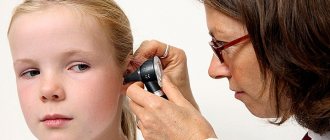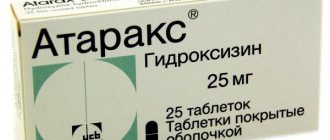Symptoms and stages of rhinitis in children
If the nasal mucosa is healthy, it is a barrier to pathogenic microorganisms. Often the protective functions of the mucosa are reduced, especially under unfavorable conditions. A runny nose occurs in a baby when infections penetrate the mucous membrane and begin to actively multiply there.
Rhinitis often occurs in children due to certain characteristics of the growing body:
- The baby’s immune system is formed before the age of ten; until this age it cannot actively resist viruses and bacteria;
- the nasal passages in children are narrow, the cavities are small, and at the slightest formation of swelling, nasal congestion occurs;
- babies do not yet know how to blow their nose; bacteria actively multiply in the dried mucus remaining on the wall (this becomes the cause of a long runny nose in a child).
Most often, a runny nose goes through three main stages: irritation, serousness and the appearance of mucopurulent discharge. The first stage is accompanied by dryness in the nose, burning, and possibly a slight increase in temperature. At the second stage, mucus in the nose begins to actively form, congestion and lacrimation occur. The third stage, which appears on days 4-5, manifests itself clearly. When you blow your nose, yellowish-green mucus with an unpleasant odor is released.
Most often, the third stage is the final one, lasts only a couple of days and the symptoms begin to subside. At this stage and for a speedy recovery, it is important to use local medications, for example, Tizin for children, which will kill the breeding ground of pathogenic microbes in the nose and relieve swelling.
In addition, using drops will protect the baby from complications, because an infection from the nasal cavity can easily penetrate inside, infecting the throat and upper respiratory tract. Prolonged nasal congestion can also lead to hypoxia, that is, oxygen starvation, since the baby's breathing through the nose is blocked.
Types of rhinitis
There are several forms of the disease, which differ in their causes: common runny nose, chronic bacterial rhinitis, vasomotor (medicinal), allergic, sinusitis. Anomalies of adenoids and polyposis affect the secretion of permanent secretions in a child.
Allergic rhinitis
The cause of allergic rhinitis is the body's sensitization to certain substances. Allergens enter the nasal mucosa and cause a conflict between antigens and antibodies. The released histamine provokes:
- bouts of sneezing;
- discharge of watery fluid without purulent formations;
- congestion of the nasal passages.
Allergic lingering runny nose is accompanied by redness of the eyes, photophobia, and headaches. When the allergen is identified and removed from the body, the child’s runny nose stops.
Chronic bacterial rhinitis
The causative agents of bacterial chronic rhinitis are microorganisms that live saprophytically on the nasal mucosa (staphylococci, streptococci, pneumococci). If the mucous membrane is damaged due to a runny nose or hypothermia, pathogens begin to multiply intensively. The child exhibits the following symptoms:
- a large amount of mucopurulent or purely purulent exudate is released;
- damage to the nasal cavities and swelling are determined;
- content of blood epithelial cells in mucus.
Bacterial rhinitis is considered a complication of untreated common viral rhinitis. Their danger lies in the spread of the inflammatory process to neighboring anatomical areas: pharynx, ears, bronchi, paranasal sinuses.
Chronic sinusitis
Inflammation of the paranasal sinuses, which is based on a bacterial infection. Moved from the nasal passages to a system of hollow chambers located between the orbit and the nasal cavity. The cause may be viral diseases such as influenza, respiratory infections or pneumonia.
There have been cases of the development of chronic sinusitis associated with congenital anatomical anomalies (deformed nasal septum, narrow passages). The disease in children manifests itself with symptoms:
- clear or purulent discharge;
- difficulty breathing due to nasal congestion;
- dry mouth;
- bad breath;
- the child gets tired quickly, even with minor exertion.
During an exacerbation of sinusitis, a prolonged runny nose may be accompanied by severe headaches localized in the frontal part and high (up to 39) body temperature.
Drug-induced rhinitis
The main cause of the disease is uncontrolled or prolonged use of vasoconstrictor drops. Nasal medications not only relieve the unpleasant symptoms of a runny nose, but also have side effects. With prolonged use, atrophy of the nasal mucosa occurs, which leads to its dysfunction and drug-induced chronic rhinitis. Vasomotor rhinitis in a child can be determined by the following signs:
- congestion of the respiratory passages;
- headache;
- irritability, sleep disturbance.
The mucous membrane swells, the child does not breathe through his nose. Discharge may be absent or insignificant. The nasal cavity dries out. Microcracks are possible, opening the way for bacterial infection. In order to get rid of a prolonged runny nose caused by medication, it is enough to give up vasoconstrictor drugs.
Adenoids and polyps
The cause of a long runny nose in children can be abnormal growth of adenoid tissue. In most cases, this occurs from frequent diseases of the upper respiratory tract. Each infection directly affects the tonsils, causing them to increase in size. After getting rid of viruses and bacteria, they are restored. If rhinitis is chronic, the lymphoid tissue begins to grow slowly.
Inflamed palatine tonsils cannot cope with their protective function, the immune system weakens, the child is more often affected by respiratory infections, they last much longer, accompanied by a prolonged runny nose.
Nasal polyps are a common occurrence in children. Polyposis is characterized by a benign growth on the mucous membrane of the paranasal sinuses. It blocks the respiratory passages, causing frequent infections in the nasopharynx. Symptoms that can help determine the presence of polyps:
- nasal congestion;
- sneezing;
- long runny nose;
- loss of smell.
One of the characteristic signs of polyps is a change in sounds when speaking. They are unclear, with a so-called pronunciation. Hearing deterioration is noted.
Types and causes of runny nose in a child
Experts divide runny nose in children into several types, which differ in the method of treatment depending on the causes.
Types of rhinitis:
- Spicy. It occurs most often accompanying ARVI or a cold. The cause can be viruses, sometimes bacteria and fungi. Hypothermia, temperature changes, dirty air, sinusitis or the presence of adenoids can trigger the appearance of snot. It develops quickly and is accompanied by headache.
- Chronic. It is a little reminiscent of the acute form, but the symptoms are not so pronounced. Nasal breathing is disrupted gradually, first one passage is blocked, then another. The voice may change. The cause of the development of a prolonged viral runny nose is untreated acute rhinitis, hormonal and endocrine disorders, and bronchial asthma.
- Chronic hypertrophied. Nasal breathing is difficult constantly and for a long time. In this case, the baby suffers from a headache, may not feel smell and even lose the quality of hearing. This form occurs due to inflammatory processes that affect the sinuses, maxillary passages and tonsils located in the pharynx.
- Atrophic. It occurs rarely in children and is accompanied by an unpleasant odor of mucus discharged from the nose. Nosebleeds are possible due to the formation of dry crusts on the walls. If the pathology is neglected, the nose may become deformed due to compaction of the bone part. This effect is called "duck nose".
- Nonspecific (vasomotor) rhinitis in children. This form of runny nose can appear even in healthy children, since it is not caused by viruses or bacteria. Rhinitis of this form is of two types: allergic and neurovegetative. The first option can have both a seasonal and year-round form, as it occurs under the influence of certain allergens. The second type is associated with disorders of the central and peripheral nervous system. It can also be provoked by malfunctions of the thyroid gland.
- Medication. Occurs due to the abuse of drugs to narrow blood vessels. As a result of prolonged exposure to drops or spray, the mucous membrane swells and atrophies.
- Traumatic. Occurs due to mechanical damage to the septum in the nose. Often accompanied by copious discharge from one nasal passage.
Prolonged runny nose in a child: possible causes, diagnosis of associated pathologies, consequences
- Types of rhinitis
- Treatment
- Folk remedies
Surely every parent knows the saying: “If snot is treated, it will go away in seven days, and if not, then in a week.”
Indeed, with normal functioning of the immune system, rhinitis goes away on its own without any treatment.
However, sometimes a prolonged runny nose in a child is a symptom of a serious illness that requires medication, and in some cases, surgical therapy.
Protracted rhinitis in children can be a consequence of the following factors:
- Weakened immunity . Parents often note that, before it stops, the runny nose reappears. This is especially true for a child attending kindergarten or school. Insufficient resistance of the body to viral infection leads to re-infection. In such cases, Derinat spray is effective.
- Allergic reaction . Mucous discharge from the nose appears under the influence of a certain irritant. Such symptoms can be constant or seasonal during the flowering period of plants.
- Chronic sinusitis and other types of sinusitis . Most often, this disease is a consequence of improper treatment of acute inflammation of the sinuses.
- Vasomotor (false) rhinitis . This pathology is caused by a malfunction of the capillaries that supply the mucous membrane of the upper respiratory tract.
- Instillation of local vasoconstrictors for too long . A dangerous consequence of their use is addiction, and instead of reducing mucus secretion, its excessive secretion begins.
- Excessive dryness in the room . Newborns are especially sensitive to environmental conditions.
- Proliferation of adenoid tissue . This significantly complicates nasal breathing and causes frequent otitis media and colds.
- Congenital or acquired as a result of injury features of the anatomical structure of the nasal cavity.
Any disease is easier to treat in the initial stages. That is why, to prevent a prolonged runny nose in a child, timely treatment of ARVI and colds is necessary. In the absence of fever, you can use folk recipes. These include rinsing and inhaling with natural remedies, rinsing and acupressure of the wings of the nose, and using mustard plasters for coughs.
Dr. E.O. Komarovsky emphasizes that the main role in the prevention of a prolonged runny nose in a child is played by hardening procedures, maintaining humidity (not lower than 50%) and temperature (19 - 22°) in the room. Walking in the fresh air, playing sports, and an active lifestyle contribute to strengthening the body's defenses. A link to a video with a detailed story from a pediatrician about the prevention and treatment of rhinitis can be found on his forum.
If, despite all the measures taken, the following alarming symptoms appear, you should not postpone your visit to the doctor:
- runny nose that persists for more than 10 days;
- snoring and increasing cough at night, which causes sleep disturbances, weakness, and fatigue;
- difficulty breathing through the nose;
- constant restlessness, tearfulness; a stuffy nose makes it more difficult for infants to take the breast or bottle nipple;
- deterioration of the sense of smell and taste.
Discharge from a prolonged runny nose in children may be clear or cloudy. Thick, yellowish mucus indicates the onset of a bacterial infectious process, which requires mandatory treatment with antimicrobial agents for both local and systemic use.
The treatment regimen for persistent runny nose in children depends on its causes. It is clear that it is impossible to make a diagnosis at home, so the child should be referred to an ENT specialist. The doctor first interviews parents about the timing of the onset of rhinitis and accompanying symptoms.
The doctor will then examine your nasal cavity, a procedure called rhinoscopy. It can be carried out using special instruments or an electronic endoscope. This is how the condition of the mucous membrane and polypous formations are determined. To exclude or confirm sinusitis, an x-ray of the sinuses is required.
If the cause of a prolonged runny nose in children is exposure to any irritant, certain tests are required to accurately identify the allergen. A clinical blood test and bacterial culture of mucous secretions are also necessary.
Complications of a prolonged runny nose in children are very dangerous. This condition can cause a variety of chronic diseases, weakened immunity, and frequent infections of the ENT organs and lower respiratory tract.
Bacterial runny nose and other types of rhinitis: features of the clinical picture and treatment
Symptoms of long-term rhinitis largely depend on its cause. The same factor determines the prescription of certain medications, the duration of treatment and the prognosis of the disease. Features of bacterial and runny nose of other nature are presented below.
Viral rhinitis occurs due to the entry of a rhinovirus or adenovirus into the body. Its distinctive symptoms are:
- clear discharge;
- nasal congestion;
- weakness;
- fever;
- inflammation, redness and sore throat;
- lacrimation.
Often the disease goes away on its own within 3 to 7 days. In severe cases - antiviral agents. Allergic rhinitis is a response of the immune system to the entry of a certain irritant into the body (dust, wool, smoke or spray, pollen, fluff, etc.).
Its main features are:
- pronounced swelling of the nasal mucosa;
- clear mucous discharge;
- Possible seasonal course with exacerbations in spring and summer;
- frequent sneezing;
- absence of fever and other cold symptoms.
For therapy, antihistamines are used in the form of tablets or nasal sprays; if there is no effect, glucocorticoids are prescribed. Bacterial rhinitis is caused by bacteria such as staphylococci and streptococci. Less commonly - hemophilus influenzae and pseudomonas aeruginosa, Klebsiella, Proteus.
It proceeds as follows:
- thick mucus with a yellowish tint and an unpleasant odor;
- temperature;
- sore throat, sometimes cough;
- in acute sinusitis - pain when pressing on the sinus area, headache when bending down;
- symptoms of general intoxication by bacterial metabolic products.
Antibiotics are prescribed for treatment; at the initial stage, antimicrobial drugs are used in the form of sprays, and for severe symptoms - injections, suspensions or tablets. Reaction to dry air. Drying of the mucous membrane leads to excessive secretion of mucus.
Accompanied by the following symptoms:
- clear, copious discharge;
- snot disappears when going out into fresh air or after ventilation.
No special treatment is required, it is enough to maintain an optimal humidity regime and regularly rinse the nose with saline solutions. Vasomotor rhinitis. Symptoms are caused by circulatory disorders and changes in the structure of the mucous membrane of the nasal cavity.
Patients complain about:
- constant runny nose with copious clear discharge;
- persistent nasal congestion and difficulty breathing;
- deterioration of sense of smell;
- lack of effect from standard methods of therapy.
Treatment depends on the stage of vasomotor rhinitis. At the initial stages, antihistamines and hormonal drugs are used; in case of pronounced changes in the nasal cavity, surgical intervention is indicated.
Regardless of the genesis of a prolonged runny nose, symptomatic therapy is necessary. It consists of rinsing the nasal cavity, prescribing vasoconstrictor sprays or drops, but they cannot be used for longer than seven days.
In addition, if necessary, therapy for concomitant inflammation of the nasopharynx and diseases of the lower respiratory tract, immunostimulants, and multivitamin preparations is required. This is especially true for viral and bacterial rhinitis.
How to treat a persistent runny nose in a child: principles of drug therapy, additional procedures
The ENT doctor should determine the treatment regimen and prescribe medications after diagnosis.
Medicines for topical use are mainly used, as they have certain advantages over capsules or syrups. First of all, sprays and drops immediately begin to “work” in the nasal cavity, bypassing the digestive tract.
In addition, the active components are absorbed into the blood in lower concentrations, so the risk of side effects associated with the load on the kidneys and liver is reduced. Let us dwell on the main drugs intended to treat a persistent runny nose in a child.
Vasoconstrictor drops and sprays:
- Otrivin;
- Vibrocil;
- Nazivin;
- Nazol.
Despite the fact that the active component of these drugs is different, they act the same way - they narrow the blood vessels of the nasal cavity and reduce the secretion of mucus. It is also worth noting that the remedies have only a symptomatic effect, without affecting the cause of the runny nose. They should be used 1 drop (or injection) into each nostril up to three times a day.
Doctors emphasize that these medications cannot be used for more than 7 days. Otherwise, complications in the form of vasomotor rhinitis are possible. When purchasing a medicine, you need to pay attention to the percentage of the active substance. It is different for adults and children. Naturally based homeopathic remedies have antimicrobial and anti-inflammatory effects.
These are sprays such as:
- Euphorbium compositum;
- Delufen.
They are prescribed in a dosage of 1 - 2 doses in each nasal passage up to 4 times a day and are approved for use from an early age, during pregnancy and lactation. Intended not only for the treatment of long-term rhinitis, but also for the prevention of exacerbation of chronic processes.
Also, to treat a persistent runny nose in a child, oral homeopathic remedies are prescribed:
- Sinupret, use 1 - 2 tablets (15 - 50 drops) three times a day;
- Cinnabsin (1 tablet 3 to 10 times a day).
Hormonal preparations with glucocorticoids have a pronounced anti-inflammatory, decongestant and antihistamine effect. Intended for the treatment of prolonged runny nose caused by neurovegetative disorders, enlarged adenoids.
These are the sprays:
- Nasonex;
- Nasobek.
Their dosage varies depending on age and is 1 - 2 injections into each nostril twice a day. Nasonex is contraindicated for children under 2 years of age, and Nasobek for children under 6 years of age. They must be used after first clearing the nasal cavity of mucus. The treatment process must be supervised by a doctor. In addition, steroids suppress local immunity, so these sprays are contraindicated for viral or bacterial infections.
Natural-based drug Pinosol. Contains plant components (menthol, eucalyptus oil, pine). Has anti-inflammatory and antimicrobial effects. It is convenient to use, as it is presented on the market in the form of ointment, drops and spray. It should be used 1 - 2 drops up to 5 times a day in the first days of illness, then switch to using it three times a day. Pinosol is not intended for children under 2 years of age and is contraindicated for allergic rhinitis.
Antibacterial agents:
- Isofra (allowed from 2 years);
- Polydexa (used from 6 years).
The composition includes an antibiotic to which gram-positive and gram-negative bacteria are sensitive. The dosage is 1 spray 3 to 5 times a day for a week. Polydexa additionally contains a vasoconstrictor component. The drug is also available in the form of ear drops for the treatment of otitis media.
Saline solutions for rinsing the nasal cavity:
- Aqua Maris;
- Humer;
- Aqualor.
Sea water relieves swelling, moisturizes the mucous membrane, the procedure should be repeated up to 5 - 6 times a day. Antihistamines are used to treat allergic rhinitis. Adults and children over 6 years of age are prescribed nasal sprays in a dosage of 1 spray up to 6 times a day.
- Allergodil;
- Cromohexal.
Younger children are prescribed Erius syrup from 2 to 5 ml per day, Loratadine, Cetrin, Suprastin tablets (½ - 1 pill once a day). Sometimes they are prescribed for ARVI to eliminate the symptoms of rhinitis.
If antibiotic sprays are ineffective, antibacterial agents of the cephalosporin or penicillin group are used in the form of suspensions. The course of treatment is from 5 to 14 days. It's also worth noting that antihistamines in tablet form can cause drowsiness, so it's best to take them in the evening.
You can also treat a persistent runny nose in a child using special procedures. The so-called cuckoo is effective. During this procedure, the doctor rinses the paranasal sinuses with disinfectant solutions and removes mucus and pus with suction.
Treatment of persistent runny nose in children with folk remedies
Recipes from the arsenal of alternative medicine will help to significantly improve the effect of medications.
Symptoms of rhinitis are relieved by inhalation of warm steam from a soda solution, decoctions of medicinal herbs (St. John's wort, calendula, chamomile, eucalyptus).
It is also possible to treat a persistent runny nose in children using a compress on the wings of the nose with heated salt in a fabric bag.
Symptoms of rhinitis due to allergies will be relieved by drops of freshly squeezed beet or carrot juice. To strengthen the immune system, the child is given onion juice. To do this, chop the onion and cover it with sugar.
For the treatment of bacterial and viral rhinitis or sinusitis, the following recipes are suitable:
- drip Kalanchoe or aloe juice into your nose;
- prepare a decoction of a mixture of St. John's wort and chamomile (1 tbsp per 200 ml of boiling water), strain and drip 4 - 5 drops into the nose up to 5 times a day;
- finely chop the onion or garlic and squeeze through cheesecloth, mix the juice with water in a 1:1 ratio and use as nasal drops;
- lubricate the mucous membrane with a mixture of honey and peppermint oil.
However, treatment of prolonged runny nose in children should be carried out under the constant supervision of a doctor. Incorrect therapy can lead to an undesirable reaction from the body and irreversible changes in the nasal mucosa, which can only be corrected by surgery.
gajmorit.com>
In what cases should you urgently consult a doctor?
On average, a child's runny nose does not last more than ten days. If it drags on for a longer time, we can talk about a chronic runny nose in a child. In this case, it is important not only to choose the right treatment, but also to identify the root cause of the pathology. To do this, you should still consult a doctor.
Symptoms that should prompt you to consult a specialist:
- A runny nose that lasts more than two weeks (can be caused by bacteria).
- Rhinitis is accompanied by severe headache or ear pain, in which case a runny nose can provoke the development of meningitis, sinusitis or otitis (antibiotics are often prescribed for prolonged runny nose in children with such symptoms).
- Bloody discharge appeared, and the baby’s general condition worsened (this may indicate nasal diphtheria).
Treatment of infectious rhinitis in children
Before treating a persistent runny nose, it is necessary to show the child to a pediatrician. He will be able to determine the cause and prescribe adequate treatment to eliminate it. Therapeutic measures involve several stages.
Rinsing the nasal passages with salt-containing preparations:
| Drugs | Photo | Price |
| Salin | Check | |
| Aquamaris | From 538 rub. | |
| Rhinostop | From 35 rub. | |
| Aqualor | From 120 rub. | |
| Dolphin | From 253 rub. |
They have no side effects and can be used by children from 1 year of age. It is necessary to read the instructions to find out the concentration of sea salt in the composition; the age limit will depend on it.
To get rid of infectious runny nose, a number of antiseptic drugs have been developed that can be prescribed to children from two years of age. These include: “Sialor”, “Collargol”, “Miramistin”, “Protargol”. Can be used if the child does not have an allergic reaction to the constituent substances. In limited quantities, drugs can dry out the mucous membrane.
Vasoconstrictors are prescribed by a doctor if the antiseptic group does not produce results. Approved for children from two years of age: “Nazivin”, “Snoop”, “Vibrocil”, can be used independently only as an emergency aid for a child. The course of treatment is limited to three days.
Antibiotics are prescribed in case of prolonged rhinitis, accompanied by high fever, purulent exudate and accompanying adenoiditis. Allowed for use:
| Drugs | Photo | Price |
| Imidosaline | Check | |
| Polydex | From 312 rub. | |
| Nazol baby | From 160 rub. | |
| Isofra | From 310 rub. |
If a child’s runny nose does not go away within two weeks, this is a serious reason to visit the pediatrician.
Treatment
A prolonged runny nose occurs more often in a child than in an adult. This is caused, first of all, by a weak immune system, narrow nasal passages, and a lack of glands that cope with infections and allergens. If left untreated, rhinitis in a baby can last up to a month. Then it becomes chronic, and complications arise.
Doctors take a comprehensive approach to the treatment of rhinitis in children, using several methods at once:
- rinsing the nasal passages;
- inhalation;
- vasoconstrictor drops for a certain period of time to avoid addiction;
- taking vitamins in courses;
- treatment of other diseases, if any.
Young mothers often ask how to cure a long runny nose in a child under one year old who is teething. In this case, only washing up to six times a day will help. The drugs that are used can be in the form of drops or a spray.
It also helps with a runny nose, regardless of the cause of its occurrence, by creating a certain microclimate in the room. It is important to carry out wet cleaning in the room where the child is located every day, maintain the temperature no higher than +23 ° C and no lower than +21 ° C, and you also need to ventilate the room often. All this will have a positive effect on microcirculation in the nasal passages.
With a runny nose, if there is no high temperature, you can and should walk in the fresh air, regardless of weather conditions, experts say.
Drug treatment regimen
Therapy with medications is prescribed depending on the cause of the runny nose and cough. Treatment for allergies is significantly different from treatment for a viral or bacterial disease.
If the symptoms are of allergic origin, the following are prescribed:
- Antihistamines. Zyrtec, Tavegil, Claritin, Zodak, Suprastin and others are highly effective.
- Glucocorticosteroids. Indicated in cases where there is expiratory shortness of breath and signs of bronchial asthma. The most commonly prescribed medications are those based on salbutamol and budesonide.
- Symptomatic medications to help relieve cough and runny nose.
If the symptoms are of bacteriological or viral origin, the following are prescribed:
- General strengthening drugs. Includes vitamins, dietary supplements, and immunostimulating medications.
- General spectrum antibiotics. Indicated in the absence of positive dynamics after appropriate symptomatic therapy for 3-5 days. Only a specialist can determine the appropriate medicine.
- If the symptoms are a manifestation of influenza or ARVI, a group of drugs based on interferons is prescribed. For example, Tsitovir.
Drug therapy
You should be careful when choosing a medicine for children with a runny nose. It is important not only to relieve inflammation and minimize the possible risk of complications, but also to use those means that will not have a significant impact on the health of the child’s body. Therapy should be as effective as possible, but at the same time safe.
Remedies for prolonged runny nose in children are classified into groups:
Vasoconstrictors (decongestants) - relieve increased swelling of the mucous membrane, due to which nasal congestion is removed, but do not affect the cause (virus or infection). They are divided into groups: products with naphazoline (Sanorin, Naphthyzin), with xylometazoline (Otrivin, Xilen), with oxymetazoline (Nazol, Nazivin, Afrin). These drugs are often prescribed to children for instillation at night; the duration of therapy is no more than a week. “Nasonex” has good decongestant properties; for children with prolonged runny nose with congestion, it can be prescribed in courses. For example, a few weeks before the onset of allergic rhinitis due to pollen. It is important to check the dose with your doctor and also become familiar with the contraindications.
Softening and moisturizing. These are preparations based on sea water, which are also prescribed as a prophylaxis for infants to rinse the nose. They can be used up to 4 times a day, there are no side effects or age restrictions. The most popular products are Aqua Maris, Marimer and Aqualor.
Antihistamines. Most often prescribed to children with allergic and vasomotor forms of rhinitis. These can be syrups, drops and sprays (Erius, Vibrocil and Nosephrine).
Antiseptic. They have an antimicrobial effect and are prescribed for infectious rhinitis. But their long-term use can dry out the mucous membrane and lead to a decrease in local immunity. The following drugs stand out here: “Dekasan”, “Miramistin” and “Sialor”.
Antibacterial. Prescribed for bacterial rhinitis, they have immunomodulatory and immunostimulating properties. Do not use without a doctor's prescription. Here you can highlight the drug "Kipferon" for a runny nose caused by bacteria, "Isofra", "Tobradex" and "Bioparox".
Phytotherapeutic methods
In the treatment of runny nose in children, especially those that occur in an acute form, physiotherapy is of great importance. The most well-known and used method is inhalation. This procedure helps to moisturize the mucous membrane, thin the mucus and actively secrete it.
Experts do not recommend breathing over boiled potatoes, as this can lead to burns to the baby’s mucous membranes or sensitive skin. Inhalations of saline solution, sea salt solution with the addition of essential oils are prescribed for children with a runny nose.
Another effective physiotherapeutic method is CUV therapy, when treatment is carried out using ultraviolet rays. As a result of exposure directly to the source of infection, all pathogenic microbes are eliminated. Most often prescribed for vasomotor and infectious rhinitis in especially severe cases, when it is necessary not only to remove the inflammatory process and reduce symptoms, but also to increase local immunity. In addition, this procedure promotes the production of melanin and vitamin D. It is prescribed for frequent runny noses in children, but is not performed at elevated temperatures.
There is also UHF therapy, which is carried out using high or ultra-high frequency electric current. Prescribed to reduce pain during acute illness and to reduce swelling. This physiotherapeutic procedure is combined with drug treatment.
Treatment of a runny nose
If a child develops snot as a result of a cold, then at the initial moment he will be helped by rinsing his nose with a saline solution: saline solution or appropriate drops, which will be recommended at the pharmacy (for example, Aqualor, Aquamaris). You can drip your nose with a solution of sea salt or rinse it with infusion of chamomile or calendula.
If the child is small and does not know how to blow his nose, then diluted aloe juice is dripped into his nose to make him sneeze, then the nasal passages will clear. It is recommended for an infant to rinse his nose with mother's milk.
Diluted beet or carrot juice is instilled into a clean nose. Parents should definitely test the effects of such products on themselves to make sure that the medicine does not cause a burning sensation.
It should be emphasized: Before you start putting any medicine purchased at a pharmacy into your baby’s nose, you need to make sure that it is intended for a child of the appropriate age. A medicine with a higher concentration may cause a burn to the nasal mucosa.
If a child has a cold or snot, then in order to improve his well-being, it is necessary, first of all, to take care of normal conditions in the room (temperature 20°-22°, humidity 60-70%). To do this, the room is often ventilated and wet cleaned. A sick child must be carefully looked after and cleared of snot from the nose 6-7 times a day. To ease breathing, vasoconstrictor drugs, such as Nazivin, Otrivin, are dripped into the nose before going to bed. In addition, these drops disinfect the mucous membrane.
For children under 4 years of age, only drops are used, since their nasal passages are located too close to the auditory tubes. The liquid, coming out of the spray under pressure, enters the pipes along with mucus, which leads to otitis media, a disease much more dangerous than a slight runny nose.
It is known that there is a reflex connection between the mucous membrane of the nose and the feet. Therefore, hypothermia of the feet causes a cold and runny nose in the child. If his feet are cold outside, it is recommended to give him a warm foot bath after returning home. The same principle of warming the feet is used to treat runny noses and colds using warm socks into which dry mustard is poured. Light irritation of the nerve endings on the feet with the essential oils contained in mustard has a warming effect on the body. The main thing is that your feet are dry, as you can get a skin burn. This method is not used to treat very young children.
If a child has snot, then he should be given a lot of water, since with snot he loses fluid. In addition, frequent drinking will help cope with elevated body temperature.
Video: Features of the treatment of runny nose in children
How to cure a child’s runny nose quickly at home?
Medicines in the form of drops or sprays cannot be used for a long time. But what to do if the child’s snot does not go away, how to alleviate the baby’s condition? For this, traditional methods are used effectively and actively.
Folk remedies for rhinitis:
Garlic juice and oil. You can quickly cure a child’s runny nose at home with this miracle remedy. The juice is squeezed out using a garlic press, then a couple of drops of vegetable or olive oil are added to the resulting mass. The resulting drops should stand for up to 12 hours, only then be used. The method causes a slight tingling sensation and is used in children from the age of five.
Aloe juice and water. Take 2 fresh aloe leaves and squeeze the juice out of them. Next, dilute it with water in a ratio of 1:10, place a few drops in each nostril up to five times a day.
Herbal decoctions and soda as inhalations. Soda is exactly the alkali that helps with severe nasal congestion or severe mucus stagnation. To do this, dissolve 4 tbsp in boiling water. l. soda, you need to let it boil for a couple of minutes. Then the pan is covered with a towel, and the child breathes for up to 10 minutes. It is also useful to breathe in infusions of herbs such as mint, chamomile, and eucalyptus.
Foot baths with essential masses and mustard. In the absence of fever and in cases of acute rhinitis, baths help well. For example, instead of using children's "Tizin", which can become addictive after 5-7 days of use, it is easy, comfortable and convenient for the child to hover his legs. To do this, dissolve dry mustard in warm water. It doesn’t burn or cause itching; moreover, the baby likes this yellow water. It is important to periodically add hot water, removing the baby’s legs from the basin in advance, since it should not cool down. They also make baths with essential oils.
How to cure a persistent runny nose in a child
Any encounter with viruses first of all entails the appearance of a runny nose. It is almost never possible to get rid of it quickly. A runny nose that lasts for a week not only leads to headaches for the little man, but also significantly damages the nervous system of his parents.
Instructions
- The Russian bathhouse has always been an excellent remedy for colds and runny noses Thanks to its many beneficial actions, it will help get rid of unpleasant symptoms in a couple of days. It would be good if the steam room uses water with the addition of menthol or fir essential oils. The effect will also be enhanced by the fact that before going to the bathhouse with your child, smear the sacrum with a mixture of grated radish and horseradish at a ratio of 1:1. And after the bath, let your baby drink a mug of linden or elderberry decoction, with a small amount of juice from any sour berry.
- A good remedy for a runny nose is aloe juice. Four times a day, instill 3-5 drops into each nostril for the child and then massage the wings of the nose. Iodine also helps with chronic runny nose. Mix 2 teaspoons of boiled water with 6-7 drops of iodine, instill in the morning and evening.
- It is necessary to lubricate the nasal cavity with iodoglycerin to enhance the function of the nasal glands. The first procedures must be performed together with a doctor, and only then at home. A probe with cotton wool wound on it is inserted shallowly into the nasal cavity, and the necessary procedure is carried out.
- Various vasoconstrictor drops have a good effect. But you should not abuse them, since with prolonged use you will become dependent on them, and the signs of a runny nose will return as soon as you stop using the drops in your nose. The use of aerosols (inhalation) also has a positive effect on the treatment of nasal congestion. Pairs of plants such as calendula, peppermint, and St. John's wort flowers are used. It is also simply necessary to use drugs containing interferon - it helps strengthen the immune system and kills viruses. These products are used twice a day, morning and evening.
- To cleanse the nose of mucus, perform a rinsing procedure. For this, sea or salt water is used. You can prepare the solution yourself, but it is better to purchase it ready-made at the pharmacy. Various sprays and aerosols based on sea water are also now produced. But be careful not to overdo it with the procedures, otherwise you will simply dry out the nasal mucosa, causing even more irritation.
KakProsto.ru>
What happens if you don’t treat a child’s runny nose?
Many are sure that a runny nose is not a serious disease, that it can be left untreated, because it will go away on its own after some time. However, it is worth understanding that the nose performs several important functions in the body. It not only helps a person breathe and distinguish odors, but also acts as a kind of barrier to various viruses and microbes. In addition, the nose is involved in the formation of speech, because when there is congestion, a nasal voice appears.
If a child has a long runny nose, this can lead to unpleasant consequences in the absence of treatment, which include the following:
- disturbances in the functioning of the upper respiratory tract and cardiovascular system;
- deformation of the chest and oval of the face (with nasal congestion, the child breathes through the mouth, which somewhat modifies the facial skeleton);
- inattention appears and the quality of memory decreases (this occurs due to a lack of oxygen, which enters the body naturally, that is, through nasal breathing);
- retardation in physical development;
- sleep disturbance.
In addition, frequent rhinitis in a child can lead to the development of bronchial asthma and other allergic diseases. As a result of dysfunction of the nose, namely breathing, the cilia on the mucous membrane stop doing their job. Thus, the baby’s body becomes less protected from the effects of allergens. An untreated runny nose or lack of treatment, for example, with vasomotor rhinitis in children, can lead to its transition to a chronic form, the development of sinusitis or otitis media. Then you can’t do without taking antibiotics.
Prevention
To prevent the frequent occurrence of rhinitis in a child, it is worth resorting to preventive measures. They consist of strengthening the immune system in general, as well as local immunity. It is important, if possible, to exclude or minimize the baby’s contact with allergens, and also to refuse to visit public places during a flu epidemic.
In the autumn-winter period, it is worth giving the child vitamins, smearing the nasal passages with ointments with antiviral activity, or using essential oils for this.
Parents should also understand that a runny nose is a disease that needs to be fought, because the infection can go lower. Often, after a runny nose, a child’s throat becomes inflamed and bronchitis develops. In this case, Suprax is prescribed to the child for a long-term runny nose and cough, which affects both infections in the nose and descending microbes in the upper respiratory tract. It is important not to delay the course of the disease, but to seek help from a specialist in a timely manner.
Conclusion
A prolonged runny nose in a baby can occur due to exposure to viruses, bacteria or allergens. It is important to treat diseases comprehensively. This includes strengthening local and general immunity with vitamins and proper nutrition, drug therapy and folk remedies to combat rhinitis. In rare cases, antibiotics are prescribed to treat long-term rhinitis. But they are selected depending on the form of the disease, the cause of its occurrence and the age of the baby. You should not resort to antibiotic treatment on your own. This may lead to the development of side effects and unpleasant complications.
Also, you should not neglect the disease, since in the absence of treatment the inflammatory process goes down and contributes to disruption of the upper respiratory tract.










